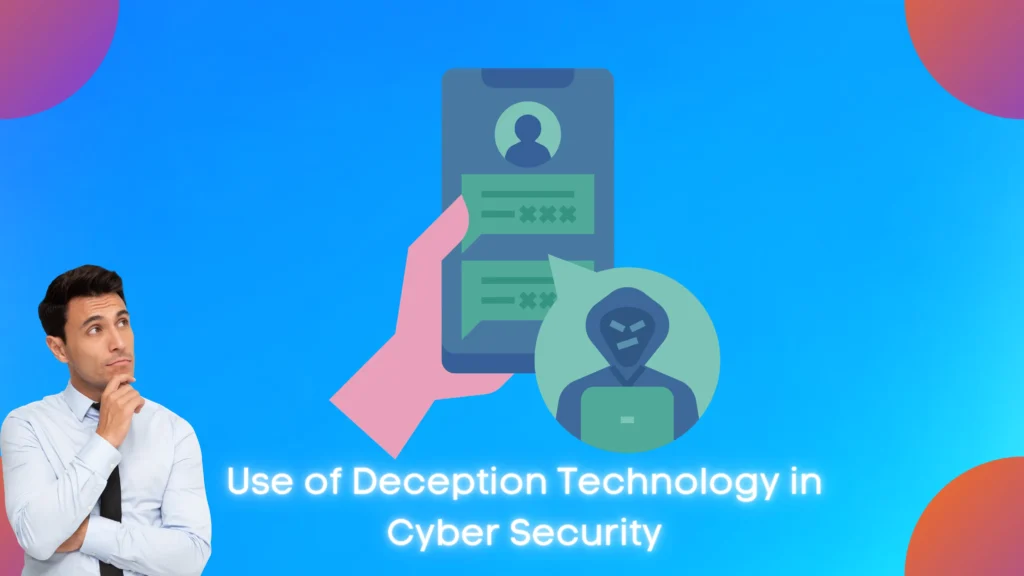Do you know what is deception technology? if yes then do you know, then what is the use of it cyber security? if not, then no problem, in today’s article, we are going to see Why do we need Deception Technology in Cyber Security? I am a cyber security expert and I guarantee you that you will not be disappointed by the information given in the article.
Introduction
Cybersecurity threats are constantly evolving, and organizations are struggling to keep up with the latest attacks. Deception technology is a relatively new approach to cybersecurity that is gaining traction as a way to detect and respond to threats. In this article, we will discuss why deception technology is becoming an essential tool in the fight against cyber threats.
Understanding Deception Technology
Deception technology involves creating a false environment, known as a “deception environment,” to mislead cybercriminals and detect their activities. This deception environment can be used to detect and respond to cyber threats, such as malware, advanced persistent threats (APTs), and insider threats.
The deception environment can be used to mimic the organization’s real environment, including its networks, systems, and data. When a cybercriminal interacts with the deception environment, it can trigger an alert and provide actionable intelligence to the security team.
Deception technology is a relatively new approach to cybersecurity that is gaining traction as a way to detect and respond to threats. It involves creating a false environment, known as a “deception environment,” to mislead cybercriminals and detect their activities. This deception environment can be used to detect and respond to cyber threats, such as malware, advanced persistent threats (APTs), and insider threats.
There are different types of deception technology, such as:
Network Deception: This type of deception creates a virtualized environment that mimics a real network. It can be used to detect unauthorized access and movement within the network.
Endpoint Deception: This type of deception creates a virtualized environment on endpoints, such as laptops and servers, to detect and respond to threats.
Application Deception: This type of deception creates a virtualized environment for applications, such as email and web browsers, to detect and respond to threats.
Data Deception: This type of deception creates a virtualized environment for data, such as creating fake sensitive data to detect data exfiltration attempts.
Deception technology can be used in conjunction with other security measures, such as intrusion detection systems (IDS) and security information and event management (SIEM) systems, to provide a more comprehensive security solution. It can also be integrated with incident response and incident management systems to provide automated responses to detected threats.
The deception environment can be configured and tailored to the specific needs of an organization and can be deployed in different ways, such as on-premises, in the cloud, or as a hybrid solution. It can also be integrated into different technologies, such as software-defined networking (SDN) and network functions virtualization (NFV), to provide a more dynamic and flexible solution. Overall, deception technology is a powerful addition to an organization’s cybersecurity strategy as it can detect and respond to threats that traditional security methods may miss.
The Current Threat Landscape
The current threat landscape is increasingly complex, with advanced threats such as APTs and ransomware becoming more prevalent. These types of attacks are difficult to detect and can evade traditional security measures.
Organizations are also facing an increasing number of insider threats, such as employees intentionally or unintentionally causing a data breach. These threats can be difficult to detect and prevent using traditional security methods.
Additionally, attackers are becoming more sophisticated in their methods, using techniques such as social engineering and phishing to gain access to sensitive information. As a result, organizations need to adopt new approaches to cybersecurity to stay ahead of these threats.
Advantages of Deception Technology
Deception technology has several advantages over traditional security methods, such as:
Early detection: Deception technology can detect cyber threats early on, allowing organizations to respond before significant damage is done.
Reduced attack surface: By creating a deceptive environment, organizations can reduce their attack surface and make it more difficult for cybercriminals to find and exploit vulnerabilities.
Increased visibility: Deception technology provides organizations with increased visibility into the activities of cybercriminals, allowing them to better understand and respond to threats.
Deception technology has several advantages over traditional security methods, such as:
Early detection: Deception technology can detect cyber threats early on, allowing organizations to respond before significant damage is done. This is a crucial advantage as traditional security methods such as firewalls, intrusion detection systems (IDS) and antivirus software can only detect known threats and signatures, but deception technology can detect unknown and advanced threats.
Reduced attack surface: By creating a deceptive environment, organizations can reduce their attack surface and make it more difficult for cybercriminals to find and exploit vulnerabilities. This is because attackers have to navigate through the deception environment before getting to the real systems, and it gives organizations an opportunity to detect and respond to the threats before they can cause any damage.
Increased visibility: Deception technology provides organizations with increased visibility into the activities of cybercriminals, allowing them to better understand and respond to threats. This is because it allows organizations to see the attackers’ behavior and techniques, which can help to improve their overall security posture.
Flexibility: Deception technology can be tailored to the specific needs of an organization, and can be used in conjunction with other security measures. This flexibility allows organizations to choose the right deception technology that best suits their specific needs and budget.
Cost-effective: Deception technology can be cost-effective as it doesn’t require organizations to invest in expensive hardware, software, or licenses. It can also be deployed on-premises, in the cloud, or as a hybrid solution, which gives organizations more flexibility in terms of deployment and scalability.
By implementing deception technology, organizations can improve their overall security posture, detect and respond to threats early on, reduce the attack surface and increase visibility and flexibility, making it a powerful addition to an organization’s cybersecurity strategy.
Flexibility: Deception technology can be tailored to the specific needs of an organization, and can be used in conjunction with other security measures.
Implementing Deception Technology
Implementing deception technology can be a complex process, and organizations should take a strategic approach. This includes:
• Conduct a thorough assessment of the organization’s security needs and current infrastructure.
• Identifying the key assets and data that need to be protected.
• Developing a deception strategy that aligns with the organization’s overall security goals.
• Regularly monitoring and reviewing the deception environment to ensure it is effective and up-to-date.
Conclusion
Deception technology is becoming an essential tool in the fight against cyber threats. Its ability to detect and respond to threats early on, reduce the attack surface, and increase visibility and flexibility, makes it a powerful addition to an organization’s cybersecurity strategy. As cyber threats continue to evolve and become more sophisticated, organizations must adopt new approaches to stay ahead of the curve. Implementing deception technology can be a complex process, but it is a necessary step in the fight against cyber threats.


